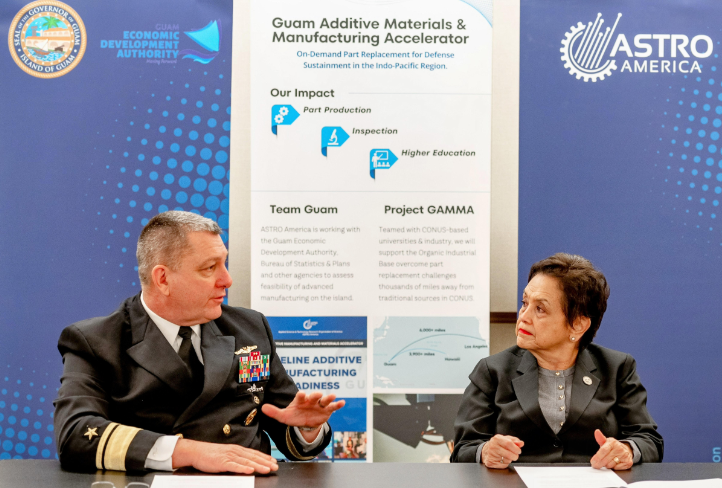For over two years, the Applied Science and Technology Organization (ASTRO) America has been working with the government of Guam to build up additive manufacturing (AM) capacity on the Pacific island territory. In January, it was announced that ASTRO and fellow non-profit, BlueForge Alliance, would be teaming up to build Guam’s first dedicated AM facility.
Further details of the plan emerged last week, at a press conference held by US Navy Rear Admiral Scott Pappano of the Program Executive Office, Strategic Submarines (PEO SSBN), and the Governor of Guam, Lourdes A. Leon Guerrero. The next leg of the plan will be rolled out in three phases, with the first — Phase 0, ‘Structure and Business Plan’ — being the above-mentioned, already-announced building of the AM facility.
In Phase 1 of the plan, ‘Staging and Transition’, which will start while the AM facility is undergoing construction, the team will start setting up equipment within “shipping container modules”, enabling them to begin qualifying tools and parts. This will also serve to get the workforce development angle to the project up-and-running. In Phase 2, ‘Deployment and Operational Launch’, the completed modules will be installed in the completed facility, students will begin coursework for “credentialed higher education”, and prototypes and end use parts for the submarine industrial base (SIB) will start being produced.
In a press release about ASTRO America’s announcement of the details for continuation of its AM project in Guam, Rear Admiral Pappano said, “The Navy is excited to be working the Government of Guam and the great team at ASTRO on this vital mission to further the national imperative for advanced manufacturing capability and the workforce to execute those requirements in a strategic location that directly benefits our ships and submarines.”
Governor Leon Guerrero said, “I am pleased to join Rear Admiral Pappano in developing this project plan, informed by the input of public and private entities across the island of Guam. This plan will create new job opportunities for Guam while contributing to America’s national security interests. It’s a win-win.”
Last week was a busy one for ASTRO, with Stifel North Atlantic’s AM Forward Small Business Invest Company (SBIC) Fund — a project ASTRO is instrumental in — finally being officially announced at the White House. In its role of midwifing AM Forward, ASTRO America is thus now at the forefront of both the R&D and financial sides of US public policy on AM.
Also noted in the press release was Rear Adm. Pappano’s mention that Guam’s AM capacity would be used to further the Australia-UK-US (AUKUS) trilateral partnership. This is just the latest sign of AUKUS’s role in accelerating the adoption of AM across the entire planet.
Considering how many military conflicts the AUKUS nations are currently involved in to one extent or another, it has become unavoidably apparent that AM is principally a national security industry. This no doubt makes many in the industry uncomfortable, and that is largely justified.
On the other hand, the buildup of AM by the DoD could — and in my opinion will — also open up many other possibilities for government funding of AM projects. The best bet for those who are uncomfortable working with DoD is to work with other areas of the US government, like the Department of Energy (DOE), to enable carbon emissions reduction, or the Department of Commerce (DOC), to help address bottlenecks in the semiconductor supply chain. The industry’s interests will be best served by the underlying technologies’ being supported to an equal extent across all areas of the federal government, and by their being adopted by as many different sectors as possible of the global economy.
Images courtesy of ASTRO America
Subscribe to Our Email Newsletter
Stay up-to-date on all the latest news from the 3D printing industry and receive information and offers from third party vendors.
You May Also Like
BLT’s 3D Printing Tech Fuels China’s Gravity-1 Rocket Launch
As China continues to advance its position in the global space race, the successful deployment of the Gravity-1 rocket by Chinese startup Orienspace last January marks a significant milestone. Launched...
GE Additive Transforms into Colibrium Additive in New Brand Move
One of the largest and most compelling companies in the 3D printing industry, GE Additive, has undergone a rebrand. Now, known as Colibrium Additive, the company and its new name...
Formlabs’ New Form 4 3D Printers Are 2-5X Faster than Form 3+
Formlabs has announced a new addition to its line of stereolithography (SLA) printers for additive manufacturing (AM): the Form 4 and Form 4B. Coming several years after the firm’s previous...
Nikon’s New Metal 3D Printer Uses 3D Scanning for Part Repair and Quality Control
Nikon has released the Lasermeister LM300A, a directed energy deposition (DED) system, along with the Lasermeister SB100 3D scanner. These two are designed to be used together. You can place...































